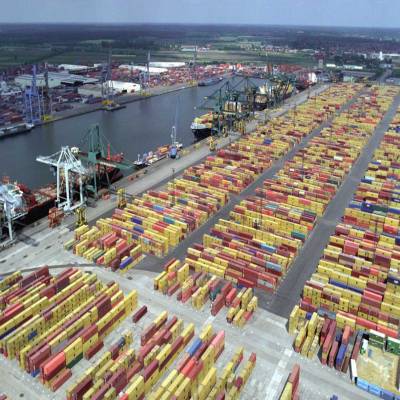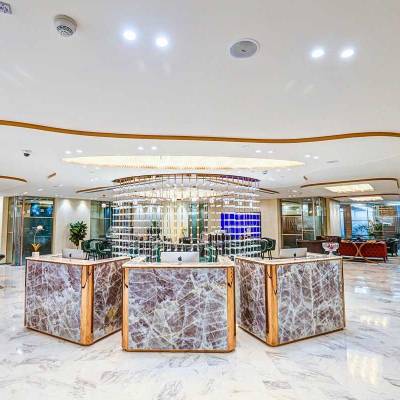- Home
- Real Estate
- Top of the Charts

Top of the Charts
Global deflationary pressures were quite fearful during the months of January and February. However, since then, the global deflationary fear has receded. Global oil prices rebounded over 80 per cent from the bottom, steel prices in China moved up as high as 30-40 per cent and many other metal and resources prices also rose significantly from the bottom. Even global agri crop prices recovered quite significantly as per the United Nation´s reports. On the domestic front too, there has been an uptick across many parameters - banking credit grows in double digits on a year-on-year (YoY) basis, FDI inflows remain robust, corporate earnings improved and tax collections (both direct and indirect taxes) have grown faster than Budget targets.
A significant fall in global deflationary fear and some improvements in domestic macroeconomic parameters along with a forecast of normal rainfall have led Indian equity markets to post relatively the best performance among most major equity markets in the world. To date, while the European markets fell up to 25 per cent, China 44 per cent, Hong Kong 29 per cent, Japan 24 per cent and Singapore market 17 per cent, India´s NIFTY gained about 2 per cent on a YoY basis. Since the beginning of the current fiscal, the Sensex moved up by about 5 per cent. Against this backdrop, we tried analysing the performance of the construction and allied sectors in terms of both business and the stock markets. This analysis has thrown up somTo share your views on this report, write in at feedback@ConstructionWorld.ine interesting insights. We have analysed business performance for the whole of FY2016 and performance on the stock markets for a period of one year ending May 15, 2016 (as most corporate results were published and the markets also discounted their stock prices for operating performance by this date).

-
The paints sector has been the top performer with a 26 per cent YoY growth in its market cap as of May 2016 as the industry benefited significantly in terms of margin expansions owing to the oil price crash, leading to impressive financial performance in FY2016.
-
The second best was the tiles and sanitary sector, which reported a 14 per cent YoY growth in market cap for the same period as the industry benefitted from softening gas prices and anti-dumping duty imposed on Chinese vitrified tiles by the government. Both sectors have outperformed the BSE Sensex index, which lost about 4 per cent of its market cap in the same period.
Construction
It is an acknowledged fact that construction has the potential to drive and revive manufacturing in any economy. The construction sector´s contribution to GDP in India has stayed fairly constant at around 9 per cent for the past three years. Strong backward and forward linkages with other manufacturing industries make this sector a natural priority for the government. It absorbs 40-45 per cent of the steel industry´s output, 85 per cent of the paint industry, 65-70 per cent of the glass industry and a significant share of the automotive, mining and excavation equipment industries. However, the construction sector has done quite poorly in terms of its contribution to the domestic economy in the past two years - while the country´s GVA (gross value added) growth during FY2015 and FY2016 were 7.1 per cent and 7.2 per cent respectively, the construction sector grew its GVA at 4.4 per cent and 3.9 per cent during the same years, grossly underperforming compared to overall economic growth.
Despite GVA growth rate slipping in FY2016 compared to FY2015, the combined net sales of 41 listed companies in this sector grew by 8 per cent YoY and operating profits increased by 17 per cent YoY in FY2016. These companies together, have also managed to turn around the bottom line - it reported a net profit of Rs.1,220 crore in FY2016 compared to a net loss of Rs 1,355 crore in FY2015.
The top performing company in terms of net profit has been Petron Engineering; on a small base, it grew its net profits six-fold YoY, while its revenues grew only by 2 per cent YoY in FY2016.

During the year ending May 15, 2016, while the Sensex fell by about 4 per cent, the construction sector underperformed and saw a 10 per cent fall in its market cap. However, Gayatri Projects saw its market cap rising 166 per cent YoY as on May 15, 2016. A reasonably large player in the construction business, Gayatri Projects posted 13 per cent YoY growth in revenues, but 166 per cent YoY growth in net profits, which enabled it to post robust wealth creation for shareholders.

Real estate
In contrast to the construction industry, the real-estate sector continues to be under stress.
Some companies in this space have posted inventory levels as high as 10 times their annual sales for FY2016.
-
The sector as a whole (47 companies) clocked sales growth of 4 per cent YoY, but net profit declined by 47 per cent YoY in FY2016 owing to significant margin pressures and interest costs. The sector´s operating profit declined by 8 per cent YoY in FY2016.
-
Owing to poor performance of the sector in terms of business, the combined market cap of 47 companies in this sector fell by 3 per cent YoY.
-
While Satra Housing, on a small base, posted a four-fold jump in net profits, Ashiana Housing and Suntech Realty, reasonably large players in real estate, posted 178 per cent and 94 per cent YoY growth in net profit respectively in FY2016. Still, their market cap de-grew by 29 per cent and 20 per cent respectively. Satra Properties, despite a four-fold jump in net profits, posted a 30 per cent de-growth in its market cap.
-
Actually, the stock market gave more importance to the strength of balance sheets rather than reported profits in the real-estate sector. A couple of real-estate companies like Oberoi Realty managed to avoid any erosion in market cap in the past one year though the growth in their profits couldn´t match these three top performers, thanks to their strong balance sheets.

Cement and cement products
In India, cement capacity is nearly 400 million tonne. In FY2014, it grew by 3 per cent and in FY2015 it grew by 6 per cent YoY, but once again volume growth fell to 3 per cent YoY in FY2016 as the Indian industrial economy almost stagnated and the capex in the infrastructure sector failed to pick up.

- This industry´s performance was quite poor in FY2016 - 31 companies have collectively posted 1 per cent YoY de-growth in revenues, but 53 per cent YoY decline in their net profits in FY2016 as operating profit slipped down 6 per cent YoY.
- However, smaller cement companies have posted robust growth in their profits - NCL Industries tops the list with about a five-fold jump in net profits in FY2016, followed by India Cements with a four-fold jump and KCP with a 170 per cent YoY increase in net profits in FY2016. These three companies saw significant improvements in their operating profits. While India Cements saw a 4 per cent de-growth in revenues, NCL Industries and KCP saw a 24 per cent and 21 per cent YoY increase in revenues respectively in FY2016.
- Despite 33 cement companies together posting significant de-growth (53 per cent YoY) in their net profits, their combined market cap rose 6 per cent YoY. Among these three top performers in terms of profits, NCL Industries created maximum wealth for shareholders as its market cap rose by 98 per cent YoY. It is followed by KCP Ltd, which saw a 24 per cent YoY increase in market cap.

Steel and steel products
The government implemented several fiscal measures to support the steel industry like hiking import duty from 7.5 per cent to as high as 12.5 per cent. For reducing stress in the steel sector, RBI has extended 5:25 scheme in July 2015 whereby a longer amortisation period for loans to projects in infrastructure and core industries, say 25 years, based on the economic life or concession period of the project, with periodic re-financing, say every five years, is allowed. Still, India´s steel consumption continues to grow in poor single digits - in FY2016, it grew at just 4.5 per cent to 80.45 million tonne as against 76.99 million tonne owing to overcapacity in the global steel industry and significant slowdown in the domestic industrial economy. In fact, domestic steel production de-grew at 1.9 per cent YoY in FY2016.
- Consequent to poor growth in domestic steel production and consumption, the steel sector´s performance in FY2016 was quite bad; 52 companies in this sector together have posted 13 per cent YoY fall in their revenues, while their collective operating profit slipped by 42 per cent YoY. In fact, the combined net loss of 52 steel companies rose 64 per cent YoY to Rs 21,649 crore in FY2016.
- However, smaller steel companies have posted robust growth in their profits - Sunflag Iron and Steel Company tops the list with about a 135 per cent jump in net profits in FY2016, followed by Prakash Industries with a 120 per cent jump and Srikalahasthi with a 93 per cent YoY increase in net profits in FY2016. While Sunflag and Prakash Industries saw 5 per cent and 28 per cent de-growth in revenues respectively, Srikalahasthi Pipes saw a 44 per cent YoY increase in revenues in FY2016.
- As core steel producers took the maximum pain of the global slowdown and steep erosion in their price realisation, companies which engaged in steel-related businesses but using core metal as inputs have actually fared better in terms of operational performance. Cheap steel prices helped them improve operating margins. While core steel and allied industry as a whole saw a 15 per cent erosion in its market cap thanks to cheap raw materials, Srikalahasthi Pipes, among the top-performing companies, posted a 48 per cent growth in its market cap during May 2015 to May 2016.

Tiles and sanitary
India is the fastest growing tile market in the world. India, China and Brazil´s tile consumption clocked 10 per cent, 10 per cent and 7 per cent CAGR over CY2004-14, respectively. The Indian tiles industry, worth Rs 22,500 crore, is the third-largest in the world in terms of production and consumption. The sector clocked an impressive 9.6 per cent volume CAGR over FY2008-2015; in value terms, it posted 15.9 per cent CAGR over the same period. According to a KPMG report on real estate, the share of the sector in national GDP is expected to increase to 13 per cent by 2028 from 6 per cent in 2013. In absolute terms, the sector´s size is estimated to increase seven times to $853 billion in 2028 from $121 billion in 2013, a CAGR of 14 per cent.

This entails humungous growth potential for the tiles industry. Even GST will be a potential game-changer for the industry. Currently, the tile industry pays a total tax of 26.36 per cent, which consists of 2 per cent CST, 12.36 per cent excise and 12 per cent VAT. Hence, if the GST rate is set at 18-20 per cent, we believe the industry´s tax rate will fall 6-8 per cent going forward. Further, players with a pan-India presence (mostly organised) will save costs related to octroi, freight, etc.
- The sector´s performance was quite impressive in FY2016 on account of softening gas prices and anti-dumping duty imposed on Chinese vitrified tiles by the government. Ten companies have collectively posted a 7 per cent YoY rise in their revenues, and a 54 per cent YoY jump in their net profits.
- The combined market cap of the 10 companies in this sector grew by 14 per cent during May 2015 to May 2016.
- Pokarna has emerged as a unique player with an impressive net profit growth of 63 per cent, operating profit growth of 59 per cent and revenue growth of 21 per cent YoY during FY2016. However, the stock failed to reward its shareholders as its market cap de-grew by 11 per cent YoY from May 2015.
- Among the top three performers in terms of financial performance, Somay Ceramics has given an impressive reward to shareholders in terms of a 36 per cent increase in its market cap during the period under study.

Paints
The Indian paint industry, estimated at around Rs 30,000 crore in FY2015, is divided between decoratives (~70 per cent) and industrials (~30 per cent). India´s paints industry has grown between 1.2 and 1.6 times GDP growth in the long term. This industry is uniquely positioned compared to other industries in the construction and allied sectors. As crude oil derivatives form a third of total raw material costs, this industry benefited significantly in terms of margin expansions owing to the oil price crash.
- Four major companies taken for the study have posted 9 per cent revenue growth in FY2016. However, their net profits collectively saw an impressive double digit growth of 51 per cent YoY.
- Interestingly, deviation in terms of performance among these four companies is not wide like other industries. However, Kansai Nerolac Paints emerges as the best performer in FY2016 with 228 per cent YoY growth in net profits.
- Among the top three performers in this industry in terms of financial performance, Berger Paints gave maximum return to shareholders with a 34 per cent rise in its market cap. The whole paint segment saw a 26 per cent rise in total market cap.

To share your views on this report, write in at feedback@ConstructionWorld.in
- CW
- EQUINOMICS RESEARCH
- Global oil
- FDI
- Sensex
- Chinese vitrified tiles
- Construction
- Petron Engineering
- Gayatri Projects
- Real estate
- Ashiana Housing
- Suntech Realty
- Satra Properties
- Oberoi Realty
- Cement
- NCL
- KCP Ltd
- Steel
- Sunflag Iron and Steel Company
- Prakash Industries
- Tiles
- Sanitary
- CAGR
- GDP KPMG
- GST
- Paints
- Somay Ceramics
- Kansai Nerolac Paints
CW and EQUINOMICS RESEARCH offer a comparative evaluation of the quarterly series of operating performance and reward to shareholders in the construction and allied sectors. Global deflationary pressures were quite fearful during the months of January and February. However, since then, the global deflationary fear has receded. Global oil prices rebounded over 80 per cent from the bottom, steel prices in China moved up as high as 30-40 per cent and many other metal and resources prices also rose significantly from the bottom. Even global agri crop prices recovered quite significantly as per the United Nation´s reports. On the domestic front too, there has been an uptick across many parameters - banking credit grows in double digits on a year-on-year (YoY) basis, FDI inflows remain robust, corporate earnings improved and tax collections (both direct and indirect taxes) have grown faster than Budget targets. A significant fall in global deflationary fear and some improvements in domestic macroeconomic parameters along with a forecast of normal rainfall have led Indian equity markets to post relatively the best performance among most major equity markets in the world. To date, while the European markets fell up to 25 per cent, China 44 per cent, Hong Kong 29 per cent, Japan 24 per cent and Singapore market 17 per cent, India´s NIFTY gained about 2 per cent on a YoY basis. Since the beginning of the current fiscal, the Sensex moved up by about 5 per cent. Against this backdrop, we tried analysing the performance of the construction and allied sectors in terms of both business and the stock markets. This analysis has thrown up somTo share your views on this report, write in at feedback@ConstructionWorld.ine interesting insights. We have analysed business performance for the whole of FY2016 and performance on the stock markets for a period of one year ending May 15, 2016 (as most corporate results were published and the markets also discounted their stock prices for operating performance by this date). The paints sector has been the top performer with a 26 per cent YoY growth in its market cap as of May 2016 as the industry benefited significantly in terms of margin expansions owing to the oil price crash, leading to impressive financial performance in FY2016. The second best was the tiles and sanitary sector, which reported a 14 per cent YoY growth in market cap for the same period as the industry benefitted from softening gas prices and anti-dumping duty imposed on Chinese vitrified tiles by the government. Both sectors have outperformed the BSE Sensex index, which lost about 4 per cent of its market cap in the same period. Construction It is an acknowledged fact that construction has the potential to drive and revive manufacturing in any economy. The construction sector´s contribution to GDP in India has stayed fairly constant at around 9 per cent for the past three years. Strong backward and forward linkages with other manufacturing industries make this sector a natural priority for the government. It absorbs 40-45 per cent of the steel industry´s output, 85 per cent of the paint industry, 65-70 per cent of the glass industry and a significant share of the automotive, mining and excavation equipment industries. However, the construction sector has done quite poorly in terms of its contribution to the domestic economy in the past two years - while the country´s GVA (gross value added) growth during FY2015 and FY2016 were 7.1 per cent and 7.2 per cent respectively, the construction sector grew its GVA at 4.4 per cent and 3.9 per cent during the same years, grossly underperforming compared to overall economic growth. Despite GVA growth rate slipping in FY2016 compared to FY2015, the combined net sales of 41 listed companies in this sector grew by 8 per cent YoY and operating profits increased by 17 per cent YoY in FY2016. These companies together, have also managed to turn around the bottom line - it reported a net profit of Rs.1,220 crore in FY2016 compared to a net loss of Rs 1,355 crore in FY2015. The top performing company in terms of net profit has been Petron Engineering; on a small base, it grew its net profits six-fold YoY, while its revenues grew only by 2 per cent YoY in FY2016. During the year ending May 15, 2016, while the Sensex fell by about 4 per cent, the construction sector underperformed and saw a 10 per cent fall in its market cap. However, Gayatri Projects saw its market cap rising 166 per cent YoY as on May 15, 2016. A reasonably large player in the construction business, Gayatri Projects posted 13 per cent YoY growth in revenues, but 166 per cent YoY growth in net profits, which enabled it to post robust wealth creation for shareholders. Real estate In contrast to the construction industry, the real-estate sector continues to be under stress. Some companies in this space have posted inventory levels as high as 10 times their annual sales for FY2016. The sector as a whole (47 companies) clocked sales growth of 4 per cent YoY, but net profit declined by 47 per cent YoY in FY2016 owing to significant margin pressures and interest costs. The sector´s operating profit declined by 8 per cent YoY in FY2016. Owing to poor performance of the sector in terms of business, the combined market cap of 47 companies in this sector fell by 3 per cent YoY. While Satra Housing, on a small base, posted a four-fold jump in net profits, Ashiana Housing and Suntech Realty, reasonably large players in real estate, posted 178 per cent and 94 per cent YoY growth in net profit respectively in FY2016. Still, their market cap de-grew by 29 per cent and 20 per cent respectively. Satra Properties, despite a four-fold jump in net profits, posted a 30 per cent de-growth in its market cap. Actually, the stock market gave more importance to the strength of balance sheets rather than reported profits in the real-estate sector. A couple of real-estate companies like Oberoi Realty managed to avoid any erosion in market cap in the past one year though the growth in their profits couldn´t match these three top performers, thanks to their strong balance sheets. Cement and cement products In India, cement capacity is nearly 400 million tonne. In FY2014, it grew by 3 per cent and in FY2015 it grew by 6 per cent YoY, but once again volume growth fell to 3 per cent YoY in FY2016 as the Indian industrial economy almost stagnated and the capex in the infrastructure sector failed to pick up. This industry´s performance was quite poor in FY2016 - 31 companies have collectively posted 1 per cent YoY de-growth in revenues, but 53 per cent YoY decline in their net profits in FY2016 as operating profit slipped down 6 per cent YoY. However, smaller cement companies have posted robust growth in their profits - NCL Industries tops the list with about a five-fold jump in net profits in FY2016, followed by India Cements with a four-fold jump and KCP with a 170 per cent YoY increase in net profits in FY2016. These three companies saw significant improvements in their operating profits. While India Cements saw a 4 per cent de-growth in revenues, NCL Industries and KCP saw a 24 per cent and 21 per cent YoY increase in revenues respectively in FY2016. Despite 33 cement companies together posting significant de-growth (53 per cent YoY) in their net profits, their combined market cap rose 6 per cent YoY. Among these three top performers in terms of profits, NCL Industries created maximum wealth for shareholders as its market cap rose by 98 per cent YoY. It is followed by KCP Ltd, which saw a 24 per cent YoY increase in market cap. Steel and steel products The government implemented several fiscal measures to support the steel industry like hiking import duty from 7.5 per cent to as high as 12.5 per cent. For reducing stress in the steel sector, RBI has extended 5:25 scheme in July 2015 whereby a longer amortisation period for loans to projects in infrastructure and core industries, say 25 years, based on the economic life or concession period of the project, with periodic re-financing, say every five years, is allowed. Still, India´s steel consumption continues to grow in poor single digits - in FY2016, it grew at just 4.5 per cent to 80.45 million tonne as against 76.99 million tonne owing to overcapacity in the global steel industry and significant slowdown in the domestic industrial economy. In fact, domestic steel production de-grew at 1.9 per cent YoY in FY2016. Consequent to poor growth in domestic steel production and consumption, the steel sector´s performance in FY2016 was quite bad; 52 companies in this sector together have posted 13 per cent YoY fall in their revenues, while their collective operating profit slipped by 42 per cent YoY. In fact, the combined net loss of 52 steel companies rose 64 per cent YoY to Rs 21,649 crore in FY2016. However, smaller steel companies have posted robust growth in their profits - Sunflag Iron and Steel Company tops the list with about a 135 per cent jump in net profits in FY2016, followed by Prakash Industries with a 120 per cent jump and Srikalahasthi with a 93 per cent YoY increase in net profits in FY2016. While Sunflag and Prakash Industries saw 5 per cent and 28 per cent de-growth in revenues respectively, Srikalahasthi Pipes saw a 44 per cent YoY increase in revenues in FY2016. As core steel producers took the maximum pain of the global slowdown and steep erosion in their price realisation, companies which engaged in steel-related businesses but using core metal as inputs have actually fared better in terms of operational performance. Cheap steel prices helped them improve operating margins. While core steel and allied industry as a whole saw a 15 per cent erosion in its market cap thanks to cheap raw materials, Srikalahasthi Pipes, among the top-performing companies, posted a 48 per cent growth in its market cap during May 2015 to May 2016. Tiles and sanitary India is the fastest growing tile market in the world. India, China and Brazil´s tile consumption clocked 10 per cent, 10 per cent and 7 per cent CAGR over CY2004-14, respectively. The Indian tiles industry, worth Rs 22,500 crore, is the third-largest in the world in terms of production and consumption. The sector clocked an impressive 9.6 per cent volume CAGR over FY2008-2015; in value terms, it posted 15.9 per cent CAGR over the same period. According to a KPMG report on real estate, the share of the sector in national GDP is expected to increase to 13 per cent by 2028 from 6 per cent in 2013. In absolute terms, the sector´s size is estimated to increase seven times to $853 billion in 2028 from $121 billion in 2013, a CAGR of 14 per cent. This entails humungous growth potential for the tiles industry. Even GST will be a potential game-changer for the industry. Currently, the tile industry pays a total tax of 26.36 per cent, which consists of 2 per cent CST, 12.36 per cent excise and 12 per cent VAT. Hence, if the GST rate is set at 18-20 per cent, we believe the industry´s tax rate will fall 6-8 per cent going forward. Further, players with a pan-India presence (mostly organised) will save costs related to octroi, freight, etc. The sector´s performance was quite impressive in FY2016 on account of softening gas prices and anti-dumping duty imposed on Chinese vitrified tiles by the government. Ten companies have collectively posted a 7 per cent YoY rise in their revenues, and a 54 per cent YoY jump in their net profits. The combined market cap of the 10 companies in this sector grew by 14 per cent during May 2015 to May 2016. Pokarna has emerged as a unique player with an impressive net profit growth of 63 per cent, operating profit growth of 59 per cent and revenue growth of 21 per cent YoY during FY2016. However, the stock failed to reward its shareholders as its market cap de-grew by 11 per cent YoY from May 2015. Among the top three performers in terms of financial performance, Somay Ceramics has given an impressive reward to shareholders in terms of a 36 per cent increase in its market cap during the period under study. Paints The Indian paint industry, estimated at around Rs 30,000 crore in FY2015, is divided between decoratives (~70 per cent) and industrials (~30 per cent). India´s paints industry has grown between 1.2 and 1.6 times GDP growth in the long term. This industry is uniquely positioned compared to other industries in the construction and allied sectors. As crude oil derivatives form a third of total raw material costs, this industry benefited significantly in terms of margin expansions owing to the oil price crash. Four major companies taken for the study have posted 9 per cent revenue growth in FY2016. However, their net profits collectively saw an impressive double digit growth of 51 per cent YoY. Interestingly, deviation in terms of performance among these four companies is not wide like other industries. However, Kansai Nerolac Paints emerges as the best performer in FY2016 with 228 per cent YoY growth in net profits. Among the top three performers in this industry in terms of financial performance, Berger Paints gave maximum return to shareholders with a 34 per cent rise in its market cap. The whole paint segment saw a 26 per cent rise in total market cap. To share your views on this report, write in at feedback@ConstructionWorld.in
























